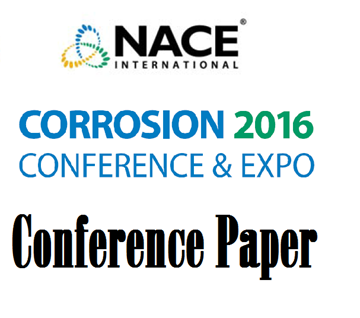Molten nitrate salts (KNO3-NaNo3) are used as Heat Transport Fluids (HTF) and energy storage materials in solar power technology. Their characteristic properties such as high specific heat high thermal conductivity high boiling point low vapor pressure and high density made them desired candidates for heat transfer applications. In solar power plants the eutectic composition of 40%KNO3-60%NaNO3 is the optimized composition of molten salt (also called Solar Salt) due to its low melting point of 223°C. While solar salts are thermally stable at up to 600°C they circulate between the power tank and the cold storage tank in a temperature range of 290°C and 565°C (Kearney et al. 2004).The combination of high operating temperature and the presence of a molten salt however present a severe corrosive environment for the common construction materials such as carbon steels low alloy steels and stainless steels. At high temperatures molten solar salts act as ionic electrolyte leading to the transportation of oxidizing agents to the metal and dissolution of metal ions into the salts. In addition commercial salts may contain different levels of impurities such as carbonates chlorides and sulfides. Among these impurities chlorides can affect the corrosive behavior of the salts significantly (Bradshaw and Clift 2010). To the best of our knowledge corrosion studies on solar salts corrosion have been conducted in temperature range of 330-570°C (Fernandez et al. 2014;Goods and Bradshaw 2004) but temperatures higher than 570°C have not yet been studied. As these salts are thermally stable up to at least 600°C increasing the operating temperature can lead to an increase of efficiency of these salts.In the present work the corrosion behavior of a ferritic-martensitic UNS 42200 steel (X20) and the stainless steel UNS31600 (316) was studied in molten solar salts at 600°C for up to 5000 hours. Attention was paid to the effect of chloride impurity level in the molten nitrate salts and the mechanism of corrosion under different chloride contents. Gravimetric and metallographic methods were used to characterize the kinetics of corrosion and the composition of the oxidation products qualitatively and quantitatively.Result showed that the ferritic-martensitic steel showed a significant mass gain by forming a thick and non-protective oxide scale after 2500h in low chloride (up to 0.02 wt%) salt. A significant increase of the corrosion rate was observed when this steel was exposed in high chloride salt (up to 0.2 wt%). Furthermore the scale underwent severe deformation in the form of buckling and cracking. The austenitic stainless steel showed superior corrosion resistance in both low chloride and high chloride salts.ReferencesBradshaw R. W. and W. M. Clift Effect of Chloride Content of Molten Nitrate Salt on Corrosion of A516 Carbon Steel Sandia Report 2010.Fernandez A. G. A. Rey I. Lasanta S. Mato M. P. Brady and F. J. Perez Corrosion of alumina-forming austenitic steel in molten nitrate salts by gravimetric analysis and impedance spectroscopy Materials and Corrosion 65(3) 267-275 2014.Goods S. H. and R. W. Bradshaw Corrosion of stainless steels and carbon steel by molten mixtures of commercial nitrate salts J. of Materi Eng and Perform 13(1) 78-87 2004.Kearney D. B. Kelly U. Herrmann R. Cable J. Pacheco R. Mahoney H. Price D. Blake P. Nava and N. Potrovitza Engineering aspects of a molten salt heat transfer fluid in a trough solar field Energy 29(5-6) 861-870 2004.




